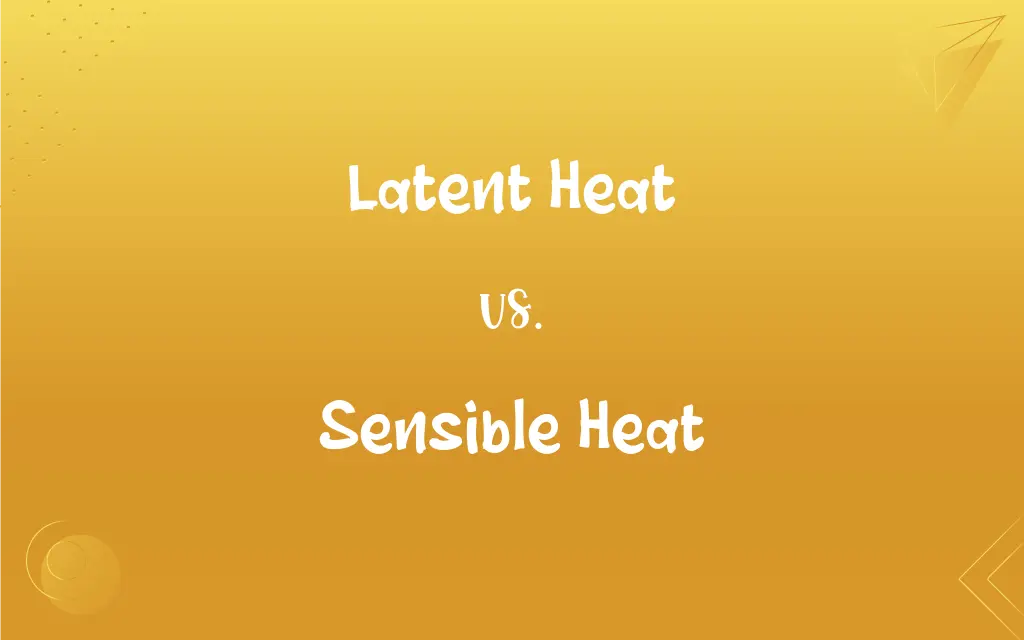Latent Heat vs. Sensible Heat: What's the Difference?
Edited by Harlon Moss || By Janet White || Published on January 2, 2024
Latent heat is energy absorbed or released during a phase change without temperature change, while sensible heat changes the temperature of a substance without altering its phase.

Key Differences
Latent heat is the heat absorbed or released by a substance during a phase change, like melting or boiling, without a temperature change. Sensible heat, on the other hand, causes a change in temperature of a substance but does not involve a phase change.
When ice melts to water, it absorbs latent heat without changing temperature. In contrast, when water is heated on a stove, it gains sensible heat, raising its temperature before boiling.
The process of condensation releases latent heat but the temperature of the substance remains constant. Sensible heat is felt as warmth or coldness in an object as its temperature increases or decreases.
Latent heat is critical in processes like refrigeration and weather systems. Sensible heat is easily measured by a thermometer and is directly related to changes in the substance's kinetic energy.
The amount of latent heat required for phase change varies by substance, and is known as the heat of fusion or vaporization. Sensible heat changes are linear with temperature changes and depend on the specific heat capacity of the substance.
ADVERTISEMENT
Comparison Chart
Definition
Heat absorbed/released during phase change without temperature change
Heat that changes temperature without phase change
Temperature Change
No temperature change during absorption/release
Direct temperature change during heat transfer
Phase Change
Involves phase change (solid, liquid, gas)
No phase change involved
Measurement
Measured as heat of fusion/vaporization
Measured by temperature change
Examples
Melting ice, boiling water
Heating water, cooling air
ADVERTISEMENT
Latent Heat and Sensible Heat Definitions
Latent Heat
Latent heat is the energy absorbed or released during a material's phase change.
The melting of ice involves the absorption of latent heat.
Sensible Heat
Sensible heat refers to the heat absorbed or lost by a substance, causing a temperature change.
Heating water on a stove increases its sensible heat.
Latent Heat
It's measured in terms of heat of fusion or vaporization.
The latent heat of fusion is key to understanding ice's melting process.
Sensible Heat
It does not involve phase changes, only temperature variations.
Cooling a room with air conditioning reduces the sensible heat.
Latent Heat
Latent heat is critical in meteorological phenomena.
Latent heat release during condensation influences weather patterns.
Sensible Heat
Sensible heat changes depend on the substance's specific heat capacity.
Different materials require varying amounts of sensible heat to change temperature.
Latent Heat
Latent heat is associated with phase transitions like melting or vaporization.
The vaporization of water releases a significant amount of latent heat.
Sensible Heat
Sensible heat can be measured directly with a thermometer.
A thermometer measures the sensible heat of the air.
Latent Heat
It is the heat transfer that occurs without a change in temperature.
During boiling, water absorbs latent heat without increasing in temperature.
Sensible Heat
It is the energy change associated with a temperature difference.
The warmth of a heated metal rod is due to sensible heat.
FAQs
What is an example of latent heat?
The melting of ice, where heat is absorbed without temperature change, is an example.
What is latent heat?
Latent heat is energy absorbed or released by a substance during a phase change without changing temperature.
Can latent heat change the temperature of a substance?
No, latent heat is absorbed or released without changing the temperature.
Is sensible heat involved in boiling water?
Sensible heat is involved until water reaches boiling point; beyond that, it's latent heat.
Can latent heat be felt?
No, unlike sensible heat, latent heat does not produce a sensation of warmth or cold.
What units are used to measure latent heat?
Latent heat is measured in joules per gram (J/g) or calories per gram.
What happens to latent heat during condensation?
Latent heat is released during condensation.
What is sensible heat?
Sensible heat is the heat that causes a temperature change in a substance without a phase change.
How is sensible heat measured?
Sensible heat is measured by the change in temperature of a substance.
What is an example of sensible heat?
Heating water in a pot, where the temperature increases, demonstrates sensible heat.
How does specific heat capacity relate to sensible heat?
Specific heat capacity determines how much sensible heat is needed to change a substance's temperature.
Does the absorption of latent heat cool the surroundings?
Yes, when a substance absorbs latent heat, it often results in cooling of the surroundings.
Do all substances have the same latent heat values?
No, different substances have different latent heat values.
Does latent heat involve phase change?
Yes, latent heat is involved in phase changes like melting, freezing, vaporization, and condensation.
Why is latent heat important in weather?
Latent heat release during water vapor condensation influences cloud formation and weather patterns.
Can latent heat be calculated?
Yes, latent heat can be calculated using the heat of fusion or vaporization values.
How does insulation affect sensible heat?
Insulation reduces the transfer of sensible heat, maintaining a stable temperature.
Are latent and sensible heat related to thermal energy?
Yes, both are forms of thermal energy transfer, but they occur under different conditions.
Is sensible heat transfer always visible?
Sensible heat transfer may not be visible, but it can be felt as a change in temperature.
What role does latent heat play in refrigeration?
Latent heat absorption is key to the cooling process in refrigeration systems.
About Author
Written by
Janet WhiteJanet White has been an esteemed writer and blogger for Difference Wiki. Holding a Master's degree in Science and Medical Journalism from the prestigious Boston University, she has consistently demonstrated her expertise and passion for her field. When she's not immersed in her work, Janet relishes her time exercising, delving into a good book, and cherishing moments with friends and family.
Edited by
Harlon MossHarlon is a seasoned quality moderator and accomplished content writer for Difference Wiki. An alumnus of the prestigious University of California, he earned his degree in Computer Science. Leveraging his academic background, Harlon brings a meticulous and informed perspective to his work, ensuring content accuracy and excellence.






































































